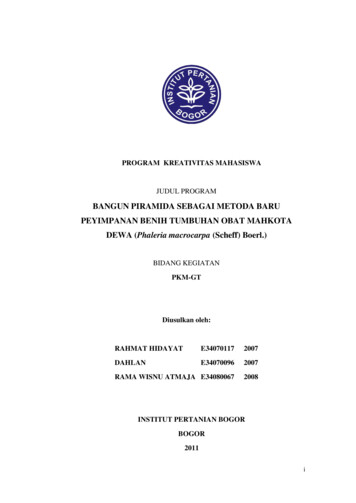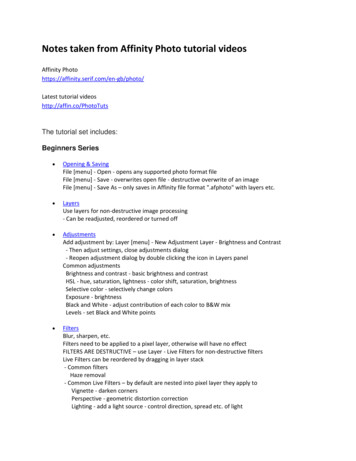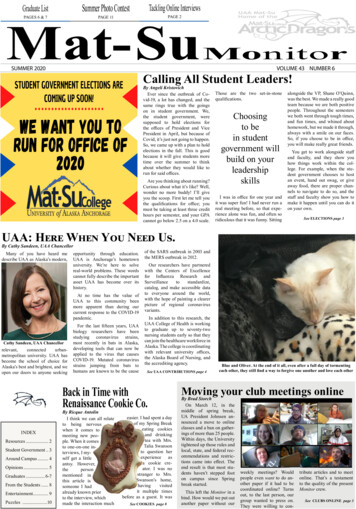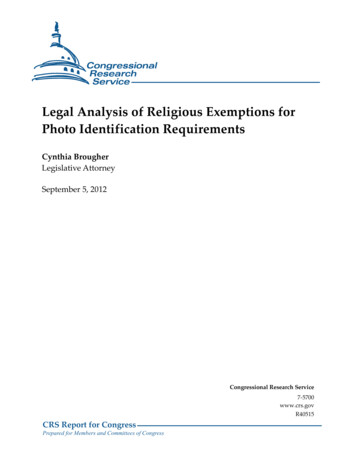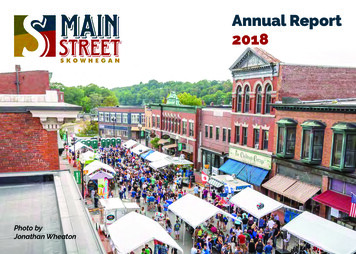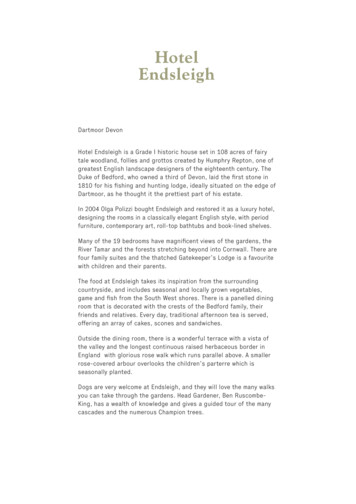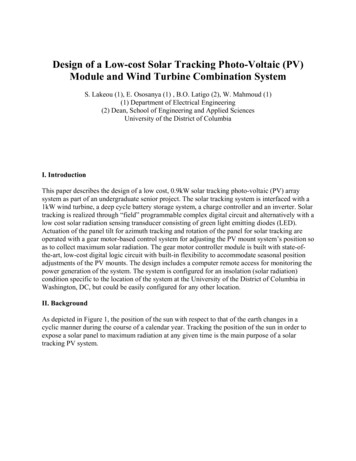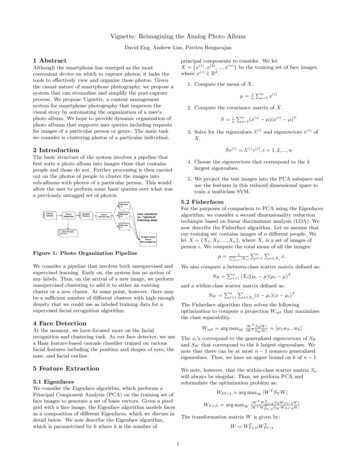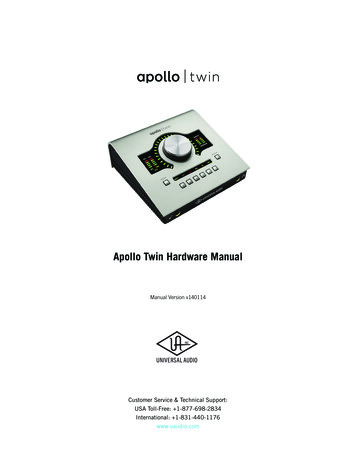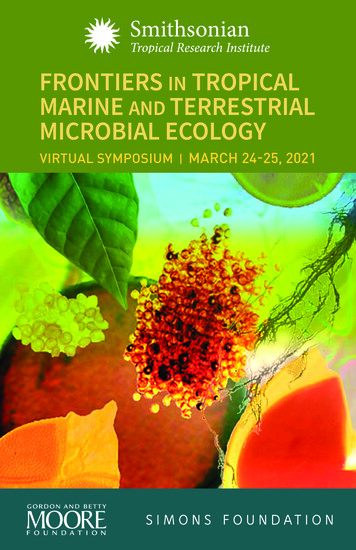
Transcription
VIRTUAL SYMPOSIUM MARCH 24-25, 20211
2Quercus costaricensis Baru. Photo courtesy of James Dalling
SUMMARYThis symposium aims to summarize our current understandingof four interconnected themes that run through on-going work intropical marine and terrestrial host-microbial interactions and theirevolution. Despite addressing many related general questions,too often researchers who study microbial evolutionary ecology ineither terrestrial or marine environments are only vaguely aware ofeach other’s paradigms, results, and ongoing studies.Given the increasingly clear, interconnected threats to biologicaldiversity, ecosystem functions, and human health, it is essential thatwe understand the roles that fungi, bacteria, archaea and virusesplay in them. There can be no question that both descriptive andfunctional knowledge are critical for any success in applied effortsaimed at natural habitat restoration or overall sustainability.Twenty-seven researchers whose investigations have focused oneither “surf” or “turf” organisms will outline what they considerto be important current knowledge in their fields, the outstandingquestions, and key next steps for both basic and applied research.Throughout this symposium, the speakers will emphasize theprofound effects that microbiomes exert on species and functionaldiversity across all levels of biological organization in both terrestrialand marine ecosystems.The Smithsonian Tropical Research Institute is grateful tothe Simons Foundation and the Gordon and Betty MooreFoundation for their support of microbial research inPanama.3
link HERE Meeting ID: 821 4930 9456 Passcode: 651987WEDNESDAY MARCH 249:00am* Welcome remarksORIS SANJUR, ACTING DIRECTORSMITHSONIAN TROPICAL RESEARCH INSTITUTE9:05am9:10amSymposium introductionALLEN HERRESMITHSONIAN TROPICAL RESEARCH INSTITUTEPLENARY TALK 30 minutesSeeing the forest for the microbes: how important are plantmicrobe interactions to the maintenance of forest biodiversity?JOSEPH LAMANNA, MARQUETTE UNIVERSITY9:40amQ&A 10 minutes9:50amBREAK 10 minutesMORNING SESSION MODERATOR:ALLEN HERRE, SMITHSONIAN TROPICAL RESEARCH INSTITUTE1 10:00am SESSION 1 The Evolutionary Ecology of Host Immune Systems:the Interface/Playground for Hosts and their MicrobiomesPrerecorded lightning talks 6 minutes eachEcological and evolutionary interactions with enemies shapesdiversity and divergence of defenses in a genus of rainforest treesPHYLLIS D. COLEY, UNIVERSITY OF UTAHPlant immune pathways and the genetics affecting diseaseresistance and microbiome assemblyLUIS MEJÍA, CENTER FOR BIODIVERSITY AND DRUGDISCOVERY, INDICASAT-AIP, PANAMAInvestigating interactions between the Pocillopora coral innateimmune system and coral-associated bacteria communitiesMICHAEL CONNELLY, UNIVERSITY OF MIAMI4* All times are Bogota/Panama time
WEDNESDAY MARCH 241 MORNING SESSION 1 CONTINUEDWhen and why do insects need microbiomes for immune function?TOBIN J. HAMMER, UNIVERSITY OF TEXAS AT AUSTINTiers of defense of multicellular host taxaANDREA L. GRAHAM, PRINCETON UNIVERSITYThe sponge holobiont from the host perspectiveLUCIA PITA, GEOMAR HELMHOLTZ CENTER FOR OCEANRESEARCH KIEL10:50am BREAK 10 minutes11:00am – 12:30pm Live Discussion SESSION 1speakers and questions from audience12:30pm – 2:00pm BREAKAFTERNOON SESSION MODERATOR:KRISTIN SALTONSTALL, SMITHSONIAN TROPICAL RESEARCH INSTITUTE2 2:00pmSESSION 2 Spatial and Temporal Scale in the Function andPhysiology of Host-Microbial InteractionsPrerecorded lightning talks 6 minutes each400 million years of symbiosis: Marine lucinid clams and thesymbionts that feed themBENEDICT YUEN, UNIVERSITY OF VIENNAExploring the microenvironmental landscape of aquaticsymbiosesMICHAEL KÜHL, UNIVERSITY OF COPENHAGEN3D bioprinted coral host microenvironmentsDANIEL WANGPRASEURT, UNIVERSITY OF CALIFORNIA SANDIEGO AND SCRIPPS INSTITUTION OF OCEANOGRAPHYMulti-host pathogens and the maintenance of forest diversityERIN SPEAR, SMITHSONIAN TROPICAL RESEARCH INSTITUTEA continental divide? Contrasting apparent benefits ofectomycorrhizal fungi in neotropical and paleotropical forestsJAMES DALLING, UNIVERSITY OF ILLINOIS* All times are Bogota/Panama time5
WEDNESDAY MARCH 242 AFTERNOON SESSION 2 CONTINUEDInteractions of root inhabiting fungi determine contrasting patternsof dominance and diversity among tropical ectomycorrhizal andarbuscular mycorrhizal treesDAVID BURSLEM, UNIVERSITY OF ABERDEENA microbiological view of the causes and consequences of coraldeclineREBECCA VEGA THURBER, OREGON STATE UNIVERSITY2:50pmBREAK 10 minutes3:00pm – 4:30pm Live Discussion SESSION 2speakers and questions from audience--------------------------- DAY 1 WRAP UP ----------------------------THURSDAY MARCH 259:00am* Welcome and introductionsALLEN HERRESMITHSONIAN TROPICAL RESEARCH INSTITUTE9:10amPLENARY TALK 30 minutesMicrobial symbioses and the future of coral reefsNANCY KNOWLTON, SMITHSONIAN INSTITUTION9:40amQ&A 10 minutes9:50amBREAK 10 minutesMORNING SESSION MODERATOR:DAVID KLINE, SMITHSONIAN TROPICAL RESEARCH INSTITUTE3 10:00am SESSION 3 Evolutionary Ecology of Microbial SymbiosesPrerecorded lightning talks 6 minutes eachThe formation of the Isthmus of Panama: a natural experimentin marine host-microbe ecology and evolutionMATTHIEU LERAY, SMITHSONIAN TROPICAL RESEARCHINSTITUTE6* All times are Bogota/Panama time
THURSDAY MARCH 253 MORNING SESSION 3 CONTINUEDExamining the natural and anthropogenic drivers affecting hostparasite interactions in marine systemsKATRINA LOHAN, SMITHSONIAN ENVIRONMENTAL RESEARCHCENTERFungal endophytes from the tundra to the tropics: leaves,seeds, and a global mosaic hypothesisELIZABETH ARNOLD, UNIVERSITY OF ARIZONAThe little things that really run the world: lessons fromlong-term plant-microbiome experiments in the fieldERIC GRIFFIN, NEW MEXICO HIGHLANDS UNIVERSITYCan metabolomics reveal the chemical-defense niches thoughtto generate and maintain tree diversity in tropical forests?BRIAN SEDIO, UNIVERSITY OF TEXAS AT AUSTINDiversification of ergot alkaloids and heritable fungal symbiontsin morning gloriesKEITH CLAY, TULANE UNIVERSITY10:50am BREAK 10 minutes11:00am – 12:30pm Live Discussion SESSION 3speakers and questions from audience12:30pm – 2:00pm BREAKAFTERNOON SESSION MODERATOR:LAETITIA WILKINS, MAX PLANCK INSTITUTE FOR MARINE MICROBIOLOGY4 2:00pmSESSION 4 Community Composition, Assembly, and Function:Implications for Restoration and RemediationPrerecorded lightning talks 6 minutes eachConnecting fungal endophyte community assembly to functionin tropical treesNATALIE CHRISTIAN, UNIVERSITY OF LOUISVILLEPhages and bacteria in coral reef holobiont interactionsMARK LITTLE, SAN DIEGO STATE UNIVERSITY* All times are Bogota/Panama time7
THURSDAY MARCH 254 AFTERNOON SESSION 4 CONTINUEDTropical forest soil microbes, carbon and climate warmingANDREW NOTTINGHAM, UNIVERSITY OF LEEDSAssembly of soil microbial communities in lowland tropical forestsKRISTIN SALTONSTALL, SMITHSONIAN TROPICAL RESEARCHINSTITUTEAre microbes responsible for decreasing marine biodiversity?A case study of coastal deoxygenation in tropical marine sedimentsNOELLE LUCEY, SMITHSONIAN TROPICAL RESEARCHINSTITUTEUsing probiotics as a treatment for stony coral tissue loss diseaseBLAKE USHIJIMA, UNIVERSITY OF NORTH CAROLINA,WILMINGTON2:50pmBREAK 10 minutes3:00pm – 4:30pm Live Discussion SESSION 4speakers and questions from audience----------------- DAY 2 WRAP UP AND NEXT STEPS ------------------8* All times are Bogota/Panama time
Photo courtesy of Phyllis D. ColeyANDSPEAKERSABSTRACTSWEDNESDAY MARCH 245
PLENARY TALKSeeing the forest for the microbes: how importantare plant-microbe interactions to the maintenanceof forest biodiversity?JOSEPH LAMANNAjoseph.lamanna@marquette.eduAcademic Affiliation:Dept. of Biological Sciences, Marquette UniversityABSTRACTFor hundreds of years, ecologists have been fascinated with widespread patterns inplant species diversity across latitudes and elevations. Mounting evidence indicatesthat interactions between plants and their microbial associates (including bothmutualists and pathogens) are important regulators of plant populations, plantspecies diversity, and the relative abundance of plant species in communities.However, substantial debate remains about the role that plant-microbe interactionsmight play in determining larger-scale patterns of biodiversity. In this talk, thecurrent state of this field is briefly reviewed and synthesized, and fundamental gapsare identified that need further study. Future studies are encouraged that test specificmechanisms by which different types of plant-microbe interactions (e.g. differentfunctional groups of mycorrhizae, pathogens, etc.) influence plant populations anddiversity maintenance. Replicated experiments across a variety of different tropicaland temperate forests will be most helpful to disentangling the influence of plantmicrobe interactions on global biodiversity patterns.Useful literature:-Jia, S., Wang, X., Yuan, Z., Lin, F., Ye, J., Lin, G., . & Bagchi, R. (2020). Tree species traits affect which natural enemiesdrive the Janzen-Connell effect in a temperate forest. Nature communications, 11(1), 1-9. Web: -Liang, M., Shi, L., Burslem, D. F., Johnson, D., Fang, M., Zhang, X., & Yu, S. 2021. Soil fungal networks moderatedensity‐dependent survival and growth of seedlings. New Phytologist. Web: h.17237-LaManna, J. A., S. A. Mangan, J. A. Myers. 2021. Conspecific negative density dependence and why its study shouldnot be abandoned. Ecosphere. 12(1):e03322. 10.1002/ecs2.3322. Web: ll/10.1002/ecs2.3322-Kandlikar, G. S., Johnson, C. A., Yan, X., Kraft, N. J., & Levine, J. M. 2019. Winning and losing with microbes: howmicrobially mediated fitness differences influence plant diversity. Ecology letters, 22(8), 1178-1191. Web: le.13280-Ke, P. J., & Wan, J. (2020). Effects of soil microbes on plant competition: a perspective from modern coexistencetheory. Ecological Monographs, 90(1), e01391. Web: s/10.1002/ecm.1391- Johnson, D. J., Clay, K., & Phillips, R. P. 2018. Mycorrhizal associations and the spatial structure of an old-growthforest community. Oecologia, 186(1), 195-204. Web: 17-3987-010
Photo courtesy of Erin SpearSESSION 1The Evolutionary Ecology of Host Immune Systems:the Interface/Playground for Hosts and their Microbiomes115
SESSION 1 The Evolutionary Ecology of Host Immune Systems:the Interface/Playground for Hosts and their MicrobiomesEcological and evolutionary interactions with enemies shapesdiversity and divergence of defenses in a genus of rainforest treesPHYLLIS D. COLEYcoley@biology.utah.eduAcademic Affiliation:University of UtahABSTRACTEcological and evolutionary interactions of plants with enemies may drive newadaptations and new species. We see evidence for this with Inga (Fabaceae), acommon and speciose rainforest tree and the insect herbivores that feed on it. Ingahas evolved a battery of defense classes, including physical defenses such as hairs,mutualisms with ants, phenological escape of vulnerable young leaves and secondarymetabolites. A typical leaf invests 50% DW in 200 defensive metabolites. All classesare independent, leading to an enormous diversity of defensive profiles across Inga.As a consequence, herbivores are extremely specialized. The high local diversityof rainforest trees is enforced by Conspecific Negative Density Dependence, withnearby neighbors being different in defenses, but not in resource acquisition traits.Additionally, the species of Inga co-occurring at a single site (eg BCI) are overdispersed with respect to chemistry. Thus, specialist herbivores are prohibiting anyone Inga species from dominating at the scale of meters as well as kilometers. Thereis no phylogenetic signal for defenses, suggesting that herbivores are driving rapid,divergent evolution of defenses. More effective escape from enemies may involvelarge changes in chemistry rather than variation on a theme. For example, oneevolutionary mechanism could be through changes in gene regulation, allowingsister species to switch from investment in phenolics to saponins. Related herbivoreschoose hosts with similar defensive traits rather than similar ancestry. These resultsdo not support reciprocal coevolution, instead herbivores are tracking defenses,feeding on hosts for which they have appropriate preadaptations.Useful literature:12-Kursar, T.A., K.G. Dexter, J. Lokvam, R.T. Pennington, J.E. Richardson, M.G. Weber, E. Murakami, C. Drake, RMcGregor and P.D. Coley. 2009. The evolution of anti-herbivore defenses and their contribution to speciescoexistence in the tropical tree genus Inga. Proceedings of the National Academy of Sciences 106:18073-18078.-Coley, P.D. and T.A. Kursar. 2014. Is the high diversity in tropical forests driven by the interactions between plants andtheir pests? Science 343: 35-36.-Endara, M-J., P.D. Coley, G. Ghabash, J.A. Nicholls, K.G. Dexter, D.A. Donoso, G. N. Stone, R.T. Pennington and T.A.Kursar. 2017. Coevolutionary arms race versus host defense chase in a tropical herbivore-plant system. Proceedingsof the National Academy of Sciences 114:E7499-7505. doi: 10.1073/pnas.1707727114.-Coley, P.D., M-J. Endara, and T.A. Kursar. 2018. Consequences of interspecific variation in defenses and herbivore hostchoice for the ecology and evolution of Inga, a speciose rainforest tree. Oecologia187:361-376. doi: 10.1007/s00442018-4080-z.-Endara, M-J., Nichols, J.A., Coley, P.D., Forrister, D.L., Younkin, G.C., Dexter, K.G., Kidner, C.A., Pennington, R.T.,Stone, G.N. and T.A. Kursar. 2018. Tracking of host defenses and phylogeny during the radiation of neotropicalInga-feeding sawflies (Hymenoptera; Argidae). Frontiers in Plant Science 9:1237. doi: 10.3389/fpls.2018.01237.-Forrister, D.L., Endara, M-J., Younkin, G.C., Coley, P.D., and T.A. Kursar. 2019. Herbivores as drivers of negative densitydependence in tropical forest saplings. Science 363:1213-1216. doi: 10.1126/science.aau9460.
SESSION 1 The Evolutionary Ecology of Host Immune Systems:the Interface/Playground for Hosts and their MicrobiomesPlant immune pathways and the genetics affecting diseaseresistance and microbiome assemblyLUIS C. MEJÍAlmejia@ndicasat.org.paAcademic Affiliation:Center for Biodiversity and Drug Discovery, INDICASAT-AIP, PanamaABSTRACTI will discuss the defensive pathways which characterize how most higher plants interactwith microorganisms. Much of the molecular and genetic basis for these pathways comesfrom studies of Arabidopsis and a few crop plants. I will give examples from my own workwith collaborators on Theobroma cacao (the source of chocolate) and Coffea arabica(the source of coffee) on how plant immune pathways are induced by dominant speciescomposing the microbiome, the role of host genetics and plant organ on microbiomeassembly. We have characterized microbial communities (microbiomes including bothpathogens and mutualists) for a range of cultivars of both of these host plants that havebeen grown under a variety of agricultural settings. We have also characterized howhost physiology and genetic expression respond to many of these microbial symbionts.Finally, we have also determined how the genetic expression of some of these symbiontsresponds to interactions with their hosts. Understanding the factors that affect plantmicrobiome assembly and their temporal dynamics promises to be of value for plantprotection against diseases in agricultural settings.Useful literature:-Christian, N., Herre, E.A., Mejia, L.C., Clay, K., 2017. Exposure to the leaf litter microbiome of healthy adults protectsseedlings from pathogen damage. Proc Biol Sci 284, 20170641. https://doi.org/10.1098/rspb.2017.0641-Cregger, M.A., Veach, A.M., Yang, Z.K., Crouch, M.J., Vilgalys, R., Tuskan, G.A., Schadt, C.W., 2018. The Populusholobiont: dissecting the effects of plant niches and genotype on the microbiome. Microbiome 6, 31. https://doi.org/10.1186/s40168-018-0413-8-Mejía, L.C., Herre, E.A., Sparks, J.P., Winter, K., García, M.N., Van Bael, S.A., Stitt, J., Shi, Z., Zhang, Y., Guiltinan,M.J., Maximova, S.N., 2014. Pervasive effects of a dominant foliar endophytic fungus on host genetic and phenotypicexpression in a tropical tree. Frontiers in Microbiology 5, 479. https://doi.org/10.3389/fmicb.2014.00479-Mejía, L.C., Rojas, E.I., Maynard, Z., Bael, S.V., Arnold, A.E., Hebbar, P., Samuels, G.J., Robbins, N., Herre, E.A.,2008. Endophytic fungi as biocontrol agents of Theobroma cacao pathogens. Biological Control 46, 4–14. eixeira, P.J.P., Colaianni, N.R., Fitzpatrick, C.R., Dangl, J.L., 2019. Beyond pathogens: microbiota interactions with theplant immune system. Current Opinion in Microbiology 49, 7–17. https://doi.org/10.1016/j.mib.2019.08.003-Wagner, M.R., Lundberg, D.S., del Rio, T.G., Tringe, S.G., Dangl, J.L., Mitchell-Olds, T., 2016. Host genotype andage shape the leaf and root microbiomes of a wild perennial plant. Nature Communications 7, 12151. https://doi.org/10.1038/ncomms1215113
SESSION 1 The Evolutionary Ecology of Host Immune Systems:the Interface/Playground for Hosts and their MicrobiomesInvestigating interactions between the Pocillopora coral innateimmune system and coral-associated bacteria communitiesMICHAEL CONNELLYmconnelly@rsmas.miami.edu michael.t.connelly01@gmail.comAcademic Affiliation:University of Miami Rosenstiel School of Marine and AtmosphericScience, University of MiamiABSTRACTReef-building corals are complex holobionts that consist of a coral host and associatedmicrobes including symbiotic algae, bacteria, viruses and micro-eukaryotes whoseinteractions are mediated by the coral innate immune system. Corals in the genusPocillopora have emerged as model species for the study of coral evolution, symbiosisand immunity because of their hardiness, persistent associations with numerousendosymbiotic microbes, and the diversity of innate immune factors (includingpattern recognition receptors, signaling pathways and defense mechanisms) presentin the P. damicornis genome. To investigate interactions between Pocillopora corals’complex immune repertoire and coral-associated bacteria communities, replicatefragments of P. damicornis and P. acuta corals from southern Taiwan were subjectedto separate experimental treatments with bacterial lipopolysaccharide (LPS) andbroad-spectrum antibiotics. LPS exposure stimulated Pocillopora coral immunityand caused upregulation of Toll-like receptors (TLRs), immune transcription factors,and pore-forming toxins such as perforin-2 but did not alter bacteria communitycomposition. Antibiotics treatments significantly decreased Pocillopora bacteriacommunity diversity and dramatically changed both coral host and Cladocopiumalgal symbiont gene expression, suggesting disruptions in the metabolic exchangesamong symbiotic partners. Altogether, these results identify novel genes andpathways involved in Pocillopora coral-symbiont-bacteria interactions and highlightthe utility of antibiotics treatments as an experimental tool to manipulate coralassociated bacteria communities.Useful literature:-Traylor-Knowles, N., & Connelly, M. T. (2017). What Is Currently Known About the Effects of Climate Change on theCoral Immune Response. Current Climate Change Reports, 3, 252–260. doi: 10.1007/s40641-017-0077-7-Connelly, M. T., McRae, C. J., Liu, P., & Traylor-Knowles, N. (2020). Lipopolysaccharide treatment stimulates Pocilloporacoral genotype-specific immune responses but does not alter coral-asso
uercus costaricensis Baru Photo courtes of ames alling. 3 . UNIVERSITY OF CALIFORNIA SAN . NATALIE CHRISTIAN, UNIVERSITY OF LOUISVILLE Phages and bacteria in coral reef holobiont interactions MARK LITTLE, SAN DIEGO STATE
